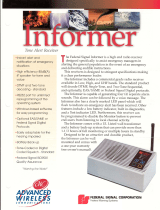
Table of Contents
1 Getting Started
1.1 Overview ..................................................................................................................................................................... 1
1.2 RIB-600Analog receiver assembly .............................................................................................................................. 2
1.3 Paging the RIB-600Analog receiver ............................................................................................................................ 3
1.4 Compatibility with other RITRON model radios ........................................................................................................... 4
1.5 Operating Conditions and Limitations .......................................................................................................................... 5
2 Installation
2.1 Radio coverage site survey ......................................................................................................................................... 6
2.2 RIB-600Analog radio receiver installation .................................................................................................................... 9
2.3 RIB-600Analog AUX IN installation ........................................................................................................................... 10
2.4 RIB-600Analog 600 BALANCED installation .......................................................................................................... 11
2.5 RIB-600Analog RELAY installation ............................................................................................................................ 12
3 Programming
3.1 PC Programming Software LM-PCPS ....................................................................................................................... 13
3.2 RIB-600Analog Field Programming Overview ........................................................................................................... 13
3.3 Readout and Field Program Frequency Codes ......................................................................................................... 14
Table F: Programmable Frequency Codes ........................................................................................................ 16
3.4 Readout and Field Program QC or DQC Tone Codes ............................................................................................... 17
Table b: Programmable QC Tone Table ............................................................................................................ 18
Table b: Programmable Digital DQC Tone Table ............................................................................................... 18
Table C: Programmable 2-Tone, DTMF and Selcall Codes................................................................................ 18
3.5 Readout and Field Program 2-Tone, DTMF or Selcall Decode Operation ................................................................. 19
3.6 Field Program Advanced Feature Codes .................................................................................................................. 20
Table A: Advanced Feature Codes .................................................................................................................... 20
3.7 Readout and Field Program RIB-600Analog Audio Level .......................................................................................... 22
Typical Audio Level Output .................................................................................................................................... 22
3.8 Readout and Field Program the NOAA Weather Frequency ..................................................................................... 23
Table d: NOAA Weather Frequency Codes ....................................................................................................... 23
3.9 Field Programming Flow Chart .................................................................................................................................. 24
4 Operation
4.1 Basic Operation ......................................................................................................................................................... 25
4.2 DTMF and Selcall Paging .......................................................................................................................................... 25
4.3 2-Tone Paging ........................................................................................................................................................... 26
4.4 Record and Play (20 seconds of record time MAXIMUM) ......................................................................................... 26
4.5 Weather Alert............................................................................................................................................................. 27
4.6 RIB-600Analog Options ............................................................................................................................................. 28
4.7 How to Minimize Feedback........................................................................................................................................ 28
4.8 Switch Input Operation .............................................................................................................................................. 29
4.9 Relay Operation ......................................................................................................................................................... 30
Radio Operation Timeline..................................................................................................................................... 30
Strobe Light Operation ......................................................................................................................................... 30
Connecting the Relay Switch to a Strobe Light .................................................................................................... 31
5 Specifications
5.1 General ...................................................................................................................................................................... 32
5.2 RPS-1B Power Cube ................................................................................................................................................. 32
5.3 RIB-600Analog Receiver ........................................................................................................................................... 33
6 Warranty ........................................................................................................................................................................ 34























